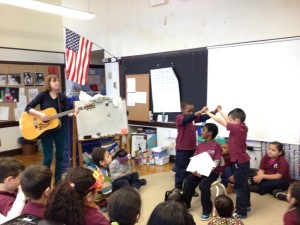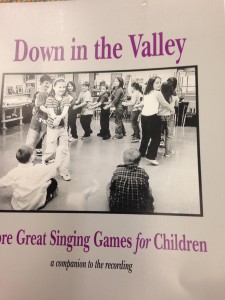
Students at the Gardner Pilot Academy act out my musical version of The Three Little Pigs (which was written at the Gardner several years ago).
This is the second in a series of posts about learning through play.
I had the opportunity to attend the Massachusetts Music Educators’ Annual conference for the first time this past weekend. This is my first year “officially” to be a music teacher for elementary school students, and I gained some new perspective about the job.
I got a short sales pitch on recorders (and a free recorder), talked to a music department head whose principal wants to cut the music programs to make room for more instruction in “core academics,” (I gave her my card if she needs an ally) and wandered through displays of K-8 music curricula, lollipops to sell for band fundraisers, and shiny brass instruments and violins.
Then I found something familiar: a four-part workshop led by Andy Davis of the New England Dancing Masters. Andy is a quintessential Vermonter – his remarks are peppered with references to contradances and squaredances, grange halls and old-fashioned storytelling. The Dancing Masters have created many books of traditional movement songs and dances with appeal to all ages.
Andy’s workshops had a following. He had participants up and dancing and making music the old fashioned way. His instruments were body percussion, an accordion and occasionally a piano. The heart of the workshop was dancing with friends and acting out stories to music. No computers, no data, no rubrics. Just getting back to the real basics: people of all ages having fun and exploring the human condition and elemental themes such as love, evil and death.
I like to think that’s what kids have a chance to do when they act out my musical stories such as “The Royal Children” (a gender-neutral version of the Dancing Masters’ “Thorn Rosa”), the Three Little Pigs and the Three Billy Goats Gruff. It’s what kids have experienced at my summer drama camps, in which we’ve built stories – mostly classic myths and folktales – into musical plays from the ground up. Kids understand more about evil when they’ve actually played the big bad wolf or the menacing troll. They love acting out ways to show that bad guys will get what’s coming to them: good-bye bad wolf! You’re no match for our brick house!
Andy’s workshop featured the story-song of Old Roger, a tale of death. It’s a simple movement activity in which Roger (having passed on) is buried with an apple tree to mark his grave. A woman comes to gather some apples from the ground, and Roger springs out of his grave and scares her! She goes hippity-hop! Roger can even get up and pursue her around the tree. It’s not in the song, but I think the story should end with the woman gently encouraging Roger to go back to his grave. This ending is consistent with other folktales of this nature.
The song has its roots in English/Scottish folk culture (although I found one reference on the web to the song’s popularity in Cameroon). Death is a topic we often tiptoe around in schools, but one which children are endlessly curious about. Andy made the point that in earlier times, death was much more present in children’s lives. Multiple generations often lived in the same household, and many people died at a younger age, including children who never made it to adulthood. Animals constantly were killed (dinner!).
The story’s also about the spirit world; the dead are often still a presence in our lives, waking us up and even chasing us around the apple tree.
When children act out the story, each part is played by someone in the group, including the apple tree and even the apples if you like. Multiple groups can act it out at the same time. Here are the lyrics, which can be set to varying tunes. The tune Andy used sounded similar to “Pop Goes the Weasel.”
- Ol’ Roger is dead and laid in his grave,
Laid in his grave, laid in his grave;
Ol’ Roger is dead and laid in his grave,
Oh, oh, laid in his grave, (or Hee-Hah, laid in his grave)
Oh, oh, laid in his grave.2. They planted an apple tree over his head,
Over his head, over his head;
They planted an apple tree over his head,
Oh, oh over his head,
Oh, oh over his head.3. The apples got ripe and all fell down,
All fell down, all fell down;
The apples got ripe and all fell down,
Oh, oh, all fell down,
Oh, oh, all fell down.4. There came an old woman picking them up,
Picking them up, picking them up;
There came an old woman picking them up,
Oh, oh, picking them up,
Oh, oh, picking them up.5. Ol’ Roger got up and gave her a kick, (or gave her a scare)
Gave her a kick, gave her a kick;
Ol’ Roger got up and gave her a kick,
Oh, oh, gave her a kick,
Oh, oh, gave her a kick.6. It made the old woman go hippity-hop,
Hippity-hop, hippity-hop;
It made the old woman go hippity-hop,
Oh, oh, hippity-hop,
Oh, oh, hippity-hop.
My suggested ending:
The woman told Roger, Go rest in peace,
Rest in peace, rest in peace;
The woman told Roger, go rest in peace,
Oh, oh, rest in peace.
At the end, Roger lies back down in his grave, so that the living, too, can go in peace.





